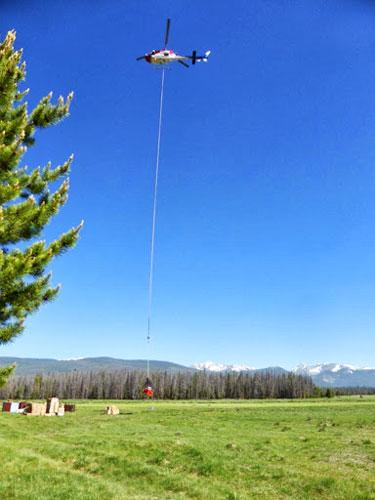The Big Meadows fire, which was started by lighting on June 10 at Rocky Mountain National Park, proved to offer an unexpected benefit for a visitor—and a park rescue team. The man was injured during a climb elsewhere in the park, and his rescue was aided by a helicopter which was assigned to personnel battling the fire.
The 36-year-old climber from Golden, Colorado, was injured on the afternoon of June 14 when he fell approximately 40 feet on Sundance Buttress, a popular climbing feature in the Lumpy Ridge area on the east side of Rocky Mountain National Park. At the time of the fall the climber was approximately 350 feet up the route, and he suffered numerous injuries in the accident.
A guide for the Colorado Mountain School was with a separate party in the area, witnessed the fall, and came to the man’s aid. The guide was able to lower the victim to the base of the route, but that was only the first step in a potentially lengthy process of getting the man to a road and then to a hospital.
This was a perfect opportunity for a "short-haul extrication," which a park spokesperson described as a specialized technique which allows rescuers to be quickly inserted into difficult terrain where a helicopter can't land. One end of a 150-foot rope is secured to a helicopter and the other is attached to a rescuer, who is then flown to the scene. Once the victim has been prepared for extraction, he and the rescuer can be secured to the end of the rope and flown to a safe location.
A short-haul is a maneuver which requires considerable skill for both rescuers and pilots, and the technique had been perfected in several NPS areas, including Yosemite, Grand Teton and Grand Canyon National Parks.
In Friday's emergency at Rocky Mountain National Park, rangers were able to request the use of the Grand Canyon Helitak Crew, which was already assigned to the Big Meadows Fire. In this situation, the patient was placed in a “Bauman Bag” with a rescuer on the end of the rope, and both were flown to a nearby meadow. The man was then taken by ambulance to Estes Park Medical Center. Details about his condition was not available.
Rangers at Rocky Mountain National Park expressed their appreciation for the support of Rocky Mountain Area Incident Management Team A in providing the helicopter and crew for this rescue operation as well for the help provided by the guide who safely lowered the injured man 350 feet to a safe location. Both steps shortened the time required to get the injured climber to the hospital.
The following short video shot during a training session by another rescue team offers a look at a short-haul using a Bauman bag to carry the victim.




Add comment